MY FAVOURITE CARTOON AS A BOY..
Monday, January 28, 2008
BROWN RAT (VIDEO)!
Sunday, January 27, 2008
THE GARDEN THIS MORNING...

.jpg)
.jpg)
Plenty of goings-on in and around the garden this morning. Three Goldfinches on the feeder (see photo above), a rat taking my bait (I missed recording this on video by a few seconds - but I will get it eventually!), the second bumblebee queen I've seen this year (saw my first yesterday), and a nice female Kestrel flying over the rec behind the house.
As I won't be able to record any shenanigans in the nestbox for over a week now (my work shifts will keep me in the office during the busy "nestbox times"), I thought I'd try to record a nice long clip this morning.
Brittany and her potential mate both obliged of course. The clip below should be viewable even if your office forbids the dreaded youtube, but I've uploaded the clip onto my youtube channel anyway (larger window than the blogger video). As usual this can be accessed by clicking on the "my youtube channel" link in the links section of BG.
You'll be able to tell the difference between Brittany and her partner I'm sure by now, and once again, I managed to record her hissing a dismissal at her mate when they are both in the box together.
Saturday, January 26, 2008
DODGY BIRD
.jpg) Female below, male above
Female below, male above.jpg)
Whilst uploading the Goldfinch video below, I noticed both Blue Tits explore the nestbox again, but unfortunately I was in no position to record inside the box, and download the video I was downloading.
The light was still poor, so you'll have to excuse the poor quality photograph I DID manage to get - this time of the very ragged looking female (Dodgy bird).
I've popped the photo of the female above (along with my old shot of the male) for comparison.
Anna thinks we should call the female "Brittany" this year, (on account of her raggedness).
I think that is a fine idea!
KING HAROLD'S BIRDS (VIDEO)
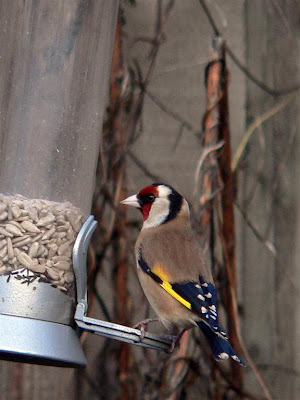.jpg)
Friday, January 25, 2008
THE MOON LAST NIGHT
.jpg)
.jpg)
Still waning. Still Gibbous...
m
n
NB. Two MORE days later, and the moon looks like this.... (photo taken on 29/01/08 at 6am approx). Only just Gibbous. Only just...
WINTER GNAT

Wednesday, January 23, 2008
IF YOU GO DOWN TO THE WOODS TODAY...
Whilst on my wander at lunchtime today, I chanced across this.
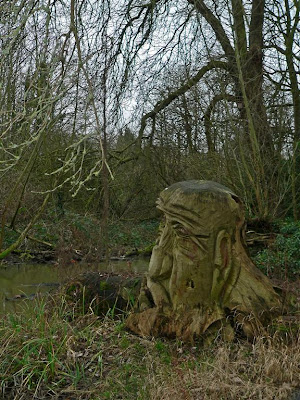.jpg)
.jpg)
MOBILE CAMERA VIDEOS NEW ON BLUE-GREY! (2)
Well, I think the camera has difficulty with lots of movement in frame (gets very pixellated), produces a pretty poor quality film (not great focus), has trouble with light on water and contrast levels (that may be my setup on the camera itself), and is very subject to noise from the wind.
That all said, I think my camera will make a very nice (free!) substitute for a proper grown-up video camera for the time being!
I really hope to make more interesting (not test) films of for example, our Woodpecker on its post (if it ever returns), and anything else that catches our eyes...
TUFTED DRAKE VIDEO
NB. The screen may look blank (with an arrow if you're lucky).
Press play (twice) anyway. It may take a moment or two "buffering" also.
Patience my child.
MOBILE CAMERA VIDEOS NEW ON BLUE-GREY!
That said, this year is going to be MIGHTY expensive, what with our wedding in August, (and honeymoon in Sri Lanka with a little luck), not to mention my Sister's wedding in May...
Soooo... I thought I'd try and investigate my own (still) camera's video capability.
I'd like (eventually) to get some nice clips (no more than 60 seconds in duration - or they take forever to download) of some birds and mammal behaviour mainly.
Maybe some badgers in the spring, or a Roe deer or two, and some bird activity as and when I find it - a song thrush belting out its dawn chorus for example, or a Short-Eared Owl even!
I went for a little wander up the river this lunchtime, to test the camera out, on some subjects that didn't require much stealth.
Above are four very short clips taken with my stills camera on video mode.
None are much more than ten seconds long - like I say, it was just a test today.
When I get time to bugger of down to th New Forest again, (or North Devon also, maybe this year), or wander off one day, locally, to find me some Grizzly Bear (you never know!), I'll try and get together a few longer clips, post them on BG and pop them on the "Teebeearr" Youtube channel.
Watch this space!
But for now, the four clips above are as follows -
1) Our overwintering Tufted Duck, with none of his kind present, getting a little flustered by the flocks of Swans and Geese on the Thames.
2) Our resident (lonesome too) Barnacle Goose - probably an escape from a local wildfowl collection - but I've seen it fly - its just a bit institutionalised, thats all!
3) A Great Crested Grebe skulking around the undergrowth in the Caversham Lock mill stream. Bad news here I'm afraid, Grapple fans. This (I think) is the mate of the hen that was sitting on eggs a week or so ago. I think the eggs were swept away, (the nest is mishapen and deserted), and the female is missing.
Their is a SLIGHT possibility that the eggs had time to hatch, and the mother is carrying her young to safety on her back. I doubt it though, as the male wouldn't be on his own if that was the case. I'll keep seaching, and keep you posted.
4) A very vocal Song Thrush, singing his heart out above that same millstream. If you listen carefully, you may be able to make out another Song Thrush that he's singing and competing against.
NB.
I should warn you here that Blogger videos are very quiet. If you want to hear any of the sounds on these (and future) videos, then watch them in a quiet place.
(Just in case you hadn't realised, I had taken the classical music off BG a month or so ago...)
FEMALE DRONE FLY
.jpg)
Tuesday, January 22, 2008
CHIFFCHAFF (2) AND FEMALE GREAT SPOTTED WOODPECKER (+RAT)

.jpg)
MOON OF THE TERRIBLE

Here are some of its (many) names again, (including celtic, pagan, japanese and even native american)!
GREAT SPIRIT MOON
COLD MOON
WOLF MOON
OLD MOON
MOON AFTER YULE
HUNGER MOON
QUITE MOON
COOKING MOON
STORM MOON
MOON OF THE TERRIBLE
Take your pick.
Lets hope the sky's clear wherever you are...
Monday, January 21, 2008
WOODPIGEON
.jpg)
FIFTEEN DEGREES CELSIUS?!
Spare a thought for the folks in north Wales (especially), the midlands, and now the north of England, who have had it a lot worse - relentless torrential rain for what seems like a week, and the probability of snow now, at least for north England and the borders.
Scotland has been chilly for the last week, but here in the south, we hit FIFTEEN DEGREES yesterday! In mid january?!
It always somewhat amuses me about this time of year to read reports in the press that:
"We're all DOOMED - the Daffs are out already!"
"I saw a lamb yesterday - WHYYYY?!"
"Was that a bumblebee that just flew by - at THIS time of year?"
There are many Daffodil varieties (especially American variants, and ones that people will see, planted in and around towns), that do flower in December or January - every year. and will continue to do so, long after the horrified onlooker has proclaimed the end of the world in the press, and joined those Daffodils as fertiliser.
Agreed, Lambing in January is early, but it happens sometimes, somewhere, every year. (There's a post on the "WAB site" (see links) about that phenomenon as I wite this).
Queen Bumblebees will often temporarily leave their winter nests if it gets a little warm.
Well.
I'll add to the hysteria then, this morning.
Our office courtyard Hedgehog (Russell, remember? The one that became arboreal during the floods) was pretty active last night and this morning. Crashing around his (her?) nest plot and courtyard flowerbed.
Again - not particularly unusual - hedgehogs will do this, if they get a little warm, during a brief peak in winter temperatures - and fifteen degrees is certainly very warm for January...
I've recently learned that January nesting (or even December sometimes) although rare in Great Crested Grebes, happens somewhere, most years - twice in this neck of the woods in the past two years - so I suppose thats the same thing too. (I guess I always knew waterbirds "march to a different drummers beat" to most birds!)
Anyway... I didn't get a photo of Russell this time.
I thought the hog would have been pretty urrm... grumpy after its slumber, so I left it alone...
We'll get a cold snap before too long, and he (she?) will be back in its hibernaculum before you can say "anthropogenically-enhanced Global Warming".
Sunday, January 20, 2008
THREE WOODPECKERS
.jpg)
.jpg)
Saturday, January 19, 2008
FENCE-POST WOODPECKERS & FENCE-POST JUMPERS




Fence-post jumpers above.
Fence-post woodpeckers below...
GREAT NEWS!
After 8 weeks or so, our "woodpecker-attracting fence-post" has finally come good!
No pictures (YET) I'm afraid, but about 30 minutes ago, Anna and I were treated to the brief sight of a Male Great Spotted Woopecker, on our suety-nutty 8'post. BRILLIANT!
The female was in the Lime tree at the same time also.
The only reason I didn't get a photo, was because within about 30 seconds after he hopped along the gate, checked out the band of red paint (to attract them) and got on the feeder proper, along came one of the 6 or so (thats all) daily cars along the service road, t'other side of the fence. Talk about bad timing!
Actually, I did get a shot, but it is so bad - I'll not post it unless I have to (ie they never return - and I cannot see that happening).
So - eight weeks of NOTHING - then two at once, and over so soon, because of one dozy car.
Grrrrrr!
I will top up the post with suet and nuts and remain vigilant, with camera poised....
They'll be back. I promise...!
As for the Fence-post jumpers.
Well, you know what those are.
I had a little exploration of my old green t-shirt which was left on the ground by the back wall of the house over the autumn and winter.
Lovely to find (at least) 3 Fence-Post jumper "lairs", and I took the opportunity to snap a few photographs of my favourite spiders...
Click to enlarge any of the above images...
Friday, January 18, 2008
MALE FUNNEL WEB / LACE WEAVER SPIDER
.jpg)
Thursday, January 17, 2008
THEY'RE STILL AROUND...
.jpg)
MUMMY LONG LEGS
.jpg)
The mother (quite literally) of "Daddy Long-Legs spiders" just ster-rolled in through the back door this morning.
SOooo... I took (yet another) shot of it (her) ambling down the hall. Note the small pedipalps (or one you can see anway (- at the front of the head)) and the much better view of her eyes in this shot.
This individual is about 20x the size of the first "DLLS" I took a shot of in the kitchen, and I'd say at least double the size of the male under the bathroom sink.
HYOWGE.
Wednesday, January 16, 2008
A DAY OFF AT THEALE LAKES

.jpg)
.jpg)
.jpg)
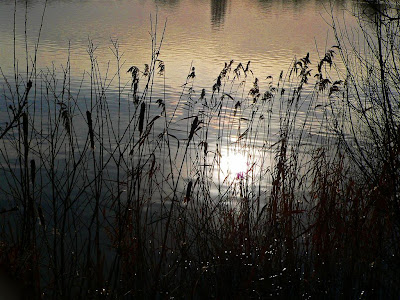.jpg)
OVERWINTERING CHIFFCHAFF!
A QUICK WORD ON OUR BLUE TITS...
.jpg)
MALE "MONEY SPIDER"
.jpg)
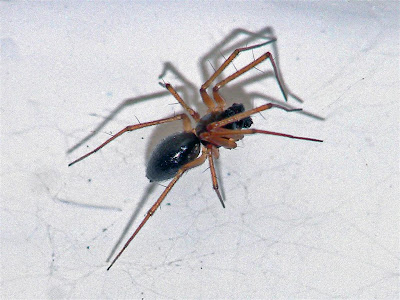.jpg)
Tuesday, January 15, 2008
"SHOEFITI"
.jpg)
.jpg)
Monday, January 14, 2008
VARIED CARPET BEETLE
.jpg)
GREY HERON
GREAT CRESTED GREBE. ON NEST?!
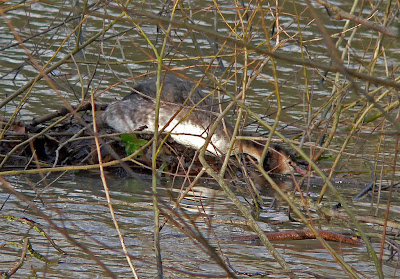.jpg)
You might be able to work it out, but if you can't, it literally means the Crested Anus-Foot.
podex=anus + pes=foot and crista=crest.
So WHY is this beautiful bird named after its backside?
This Grebe, in common with many other Grebe species, is aquatic through and through. You may see it catch a fish under water, if you are in exactly the right place at the right time (like I managed last summer), but you'll probably have trouble EVER seeing one fly.
They DO fly, of course. We have a resident opulation of about 10,000 birds, which doubles over the winter months as more fly in from colder climes.
They are incredibly clumsy on land also. Their feet are positioned SO FAR back along their body (to help with underwater hunting, speed and manoeurability when chasing small fish) that they can hardly walk on land.
Their feet are indeed, around their anus then. The crested anus-foot!

February would normally be the month one might see a pair of Great Crested Grebes performing their elaborate courtship dance, but I've come across TWO pairs in a 100m stretch of a millstream (off the Thames proper), that are already well into their breeding.
One of the hens is already sitting on three eggs, and the other pair are building their nest in earnest (pun intended).
I'm slightly worried about these Grebes. A friendly local (who just happens to be a colleague in my building) says they did this last year also, and successfully raised two chicks.
I'll keep an eye on these four birds, as the Thames is once again, bloody high at present, and I fear for the nests - not only because of the water levels, but because we haven't had a serious chill yet - there's plenty of time for that, this winter.
The Great Crested Grebe, like the Coot and the Moorhen has red eyes, although unlike those other two waterfowl, the young of the Grebe are very aesthetically pleasing. Like little black and white striped humbugs, they hitch a ride on their mother's back for some time, even though, in common with almost ALL waterbirds, they are born precocious, ie fully feathered and capable of good movement and feeding skills.
I'd like to get a shot of the young in due course.
That opportunity may present itself MONTHS sooner than I thought!
FEMALE "BRIDGE SPIDER" (2)
.jpg)
Photographed this beauty on the side of the office last night.
This is Larinioides sclopetarius, more commonly known as the "Bridge Spider" because of its preferred habitat of metal structures close to water.
Walk along a river or canal with railings - THIS is the spider that will be building its orb webs between those railings, or on the bridges, or even around the lamposts nearby- they seem to LOVE lamposts - not surprising really, as when the sun goes down, these nocturnal spiders come out, and with a web under a street light (near water remember), they are pretty well guuaranteed a feast most nights eh?
It has been recently noticed that this spider is getting rather fond of Greenhouses too, especially near ponds, be they in back gardens, or garden centres.
This seems to me to be a very sensible species of spider.
In case you weren't sure my office (at present) sits on the top floor, overlooking the river Thames - and in the summer, the floor-ceiling windows (on the outside at least) are CRAWLING with these Bridge Spiders.
Click HERE to revisit my first post on this species of spider, in May of last year.
NB.
I'm not overly impressed with the photo. It will magically change when I capture a better one...
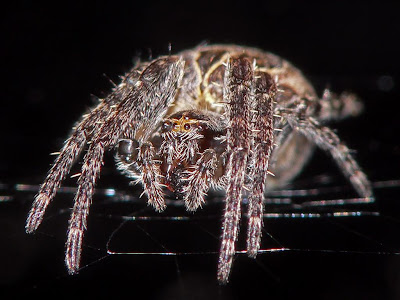.jpg)

Sunday, January 13, 2008
FIRST ICHNEUMON WASP OF THE YEAR
.jpg)
.jpg)
.jpg)
Well, this was a surprise today. Saw this from some distance, walking through our clump of thyme in the vegetable bed, and rushed to get the camera as it strolled across the path.
This is one of the 3000+ species of Ichneumon wasps in the UK, almost certainly an Amblyteles sp.
These are large, conspicuous Ichneumons with no long ovipositor, (unlike most, which are inconspicuous and dark with a very noticeable ovipositor which often gets mistaken for a huge sting).
Ichneumons are meant to be dormant over winter - not this individual though eh?
That said, it was a bit sluggish over the ground - they become MUCH harder to photograph when its warmer...

.jpg)
.jpg)
.jpg)
.jpg)





